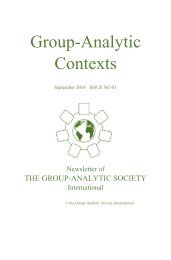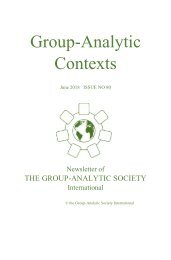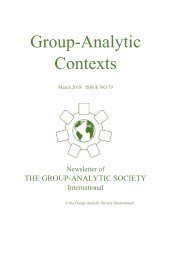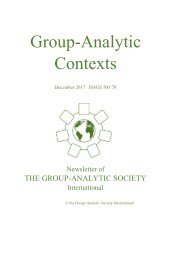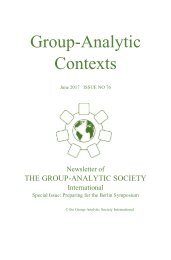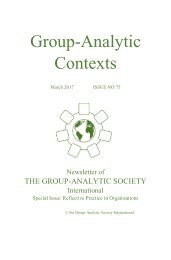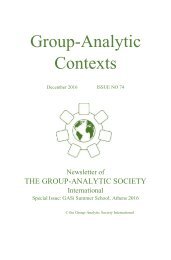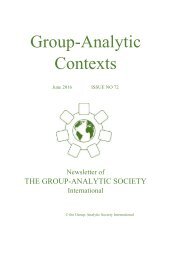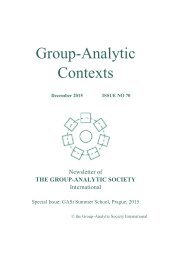Group Analytic Contexts, Issue 77, September 2017
Newsletter of the Group Analytic Society International
Newsletter of the Group Analytic Society International
You also want an ePaper? Increase the reach of your titles
YUMPU automatically turns print PDFs into web optimized ePapers that Google loves.
Newsletter – Autumn <strong>2017</strong> 27<br />
But this moved to Bonn after the wall was built.<br />
Our next stop Bernauerstrasse symbolises the social split<br />
between East and West. It is the place where the overnight<br />
construction of the Wall put a violent end to everyday life for former<br />
neighbours. From one day to the next, people could no longer travel<br />
freely to visit neighbours, friends and relatives. The house across the<br />
street suddenly became part of another political system and<br />
inaccessible. Unwittingly the people living here were caught up in an<br />
episode of post-war German history. Many desperate to escape,<br />
jumped out of windows and paid with their lives. Here it is possible<br />
to see the only section of the Berlin Wall preserved in its full width;<br />
two walls that in themselves were difficult to climb over and the ‘death<br />
strip’ between. Björn commented that it is still not as easy to move<br />
back and forth from East to West as it was after the war before the<br />
wall was erected. Something was destroyed that Is not easy to fit<br />
together. He explained that when East Germans read newspapers they<br />
see it as an official state voice whereas those from the West see it as a<br />
personal opinion. He went further, “We hear and read the same words<br />
but the pictures in our minds are different”. One titbit that I did not<br />
know: apparently Kennedy did not do anything to prevent the building<br />
of the wall, believing it would have precipitated a third world war.<br />
Imagining the wall, I had always thought of it as a clearly<br />
defined straight line with East and West easily identifiable but it was<br />
not as simple as that. In many places, the wall took a convoluted route<br />
and it was often difficult to tell which side was which. Björn gave us<br />
clue to look for newly planted birch trees but even so it was difficult.<br />
Björn suggested we look for where the bars and theatres were. That<br />
did not help me either. After I got back to Berlin I bought myself a<br />
map to track where we had been. It is a long route that doubles back<br />
on itself in many places. The journey from East to West is long! Björn<br />
told us that in the 9 years he had been a guide he had only been asked<br />
to do this trip 5 times.<br />
The first day was hard, not only because of the weather but<br />
also because we had to do most of the kilometres after lunch in one<br />
hard push along bumpy country paths all the while dodging and<br />
encouraging some very exhausted looking runners going in the<br />
opposite direction. They were competing in an extreme marathon<br />
around the whole wall in one day to commemorate the building of the<br />
wall. We finally made it to Teltow as it was getting dark just after<br />
eight o’clock exhausted. Almost all our hiking colleagues had given<br />
up waiting for us. Our attempts to make contact with them had not<br />
been successful. This was our first experience of learning that relying



